Tabasco is one of the most bio-diverse regions in Mexico, known for its abundance of wildlife, particularly its exotic bird species. Located in the southeastern region of the country, it is home to over 400 bird species, including migratory birds that find their way to this tropical paradise every year.
From colorful parrots, toucans, and hummingbirds to giant storks, majestic eagles, and elusive owls, Tabasco’s birdlife is a sight to behold.
The lush tropical forests, wetlands, and pristine coastlines provide an ideal habitat for birds to thrive, making it a prime destination for birdwatchers and ornithologists from around the world.
We will explore some of the most fascinating species of birds that call this region their home.
1. Neotropic Cormorant
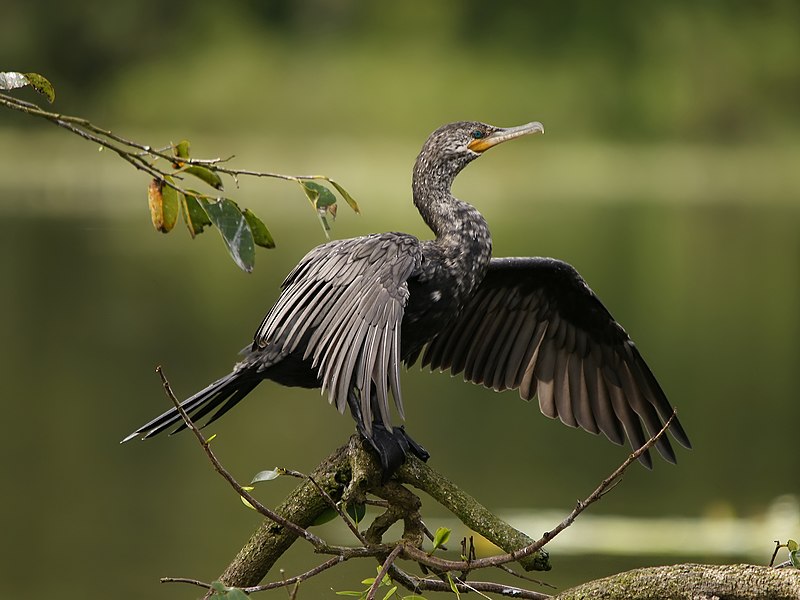
The Neotropic Cormorant, also known as the Olivaceous Cormorant, is a medium-sized bird found in tropical and subtropical regions of Central America, South America and the United States.
It can be identified by its black body with bright yellow facial skin on both sides of its large bill. The tail feathers are short and squared off at the tip.
This species breeds mainly on coasts but will sometimes nest inland near rivers or lakes during certain parts of their life cycle.
They feed mostly on small fish caught while diving underwater but can also eat crustaceans, amphibians and insects.
These birds roost in trees at night to keep safe from predators like foxes which prey upon them when they sleep close to water sources during daylight hours.Scientific classification:
| Kingdom | Animalia |
| Phylum | Chordata |
| Class | Aves |
| Order | Suliformes |
| Family | Phalacrocoracidae |
| Genus | Nannopterum |
| Species | N. brasilianum |
Also Featured In: Beautiful Brazilian Birds, Rainforest Birds You Should Know
2. Amazon Kingfisher
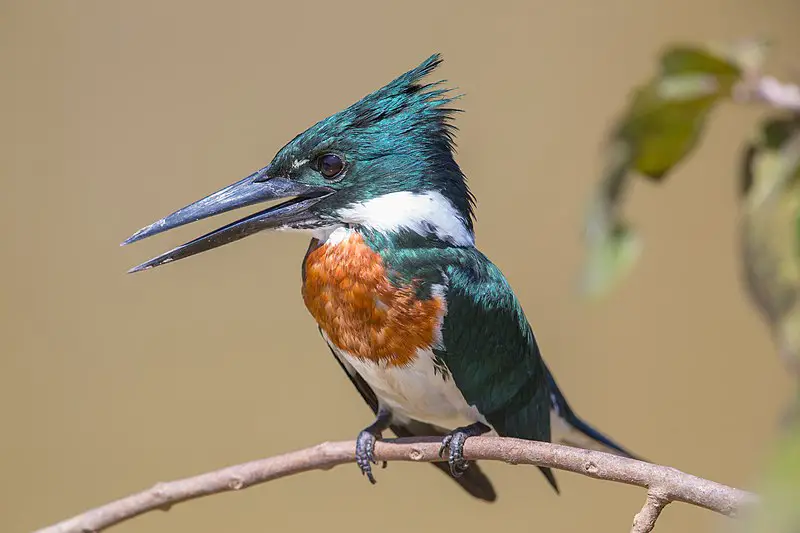
The Amazon Kingfisher is a stunning species of water kingfisher found in the lowlands of Central and South America.
It has an aqua-green head, chestnut wings with white markings, blue back and tail and yellow feet.
Its dramatic plumage makes it one of the most attractive birds in its region.
The Amazon Kingfisher can be seen perching on branches or flying close to slow moving rivers while they search for food such as fish, frogs, lizards or insects which they catch by diving into the water from above.
Despite their colorful appearance these bird are incredibly shy so it’s difficult to get too close without scaring them away.Scientific classification:
| Kingdom | Animalia |
| Phylum | Chordata |
| Class | Aves |
| Order | Coraciiformes |
| Family | Alcedinidae |
| Subfamily | Cerylinae |
| Genus | Chloroceryle |
| Species | C. amazona |
Also Featured In: Birds That Live in the Jungle, Common Tropical Rainforest Birds
3. Great-Tailed Grackle
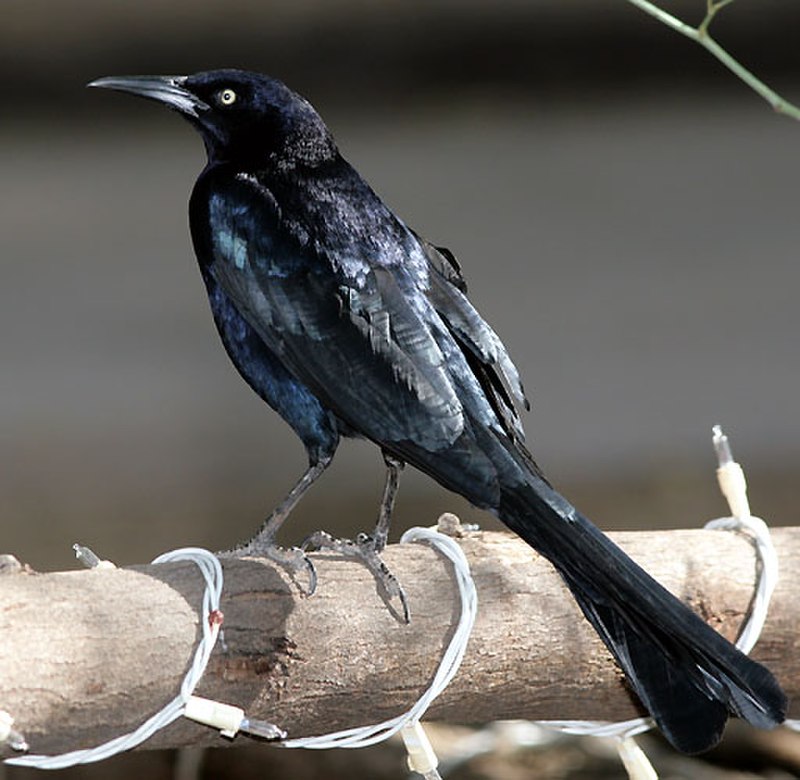
The Great-tailed Grackle is a medium sized bird native to North and South America. It belongs to the family Icteridae, making it closely related to two other species of grackles – the Boat-tailed and Slender-billed.
They are highly social birds which often appear in large flocks or colonies.
Their plumage ranges from glossy black with blue or purple iridescence, through brownish grey shades depending on location.
In some areas they have been known as “blackbirds” due their predominately dark colouring.
This adaptable species is also renowned for its distinctive long tail feathers – hence its name.Scientific classification:
| Kingdom | Animalia |
| Phylum | Chordata |
| Class | Aves |
| Order | Passeriformes |
| Family | Icteridae |
| Genus | Quiscalus |
| Species | Q. mexicanus |
Also Featured In: Top Birds Found in Mexico, Common Birds That Live in Las Vegas
4. White-Winged Dove
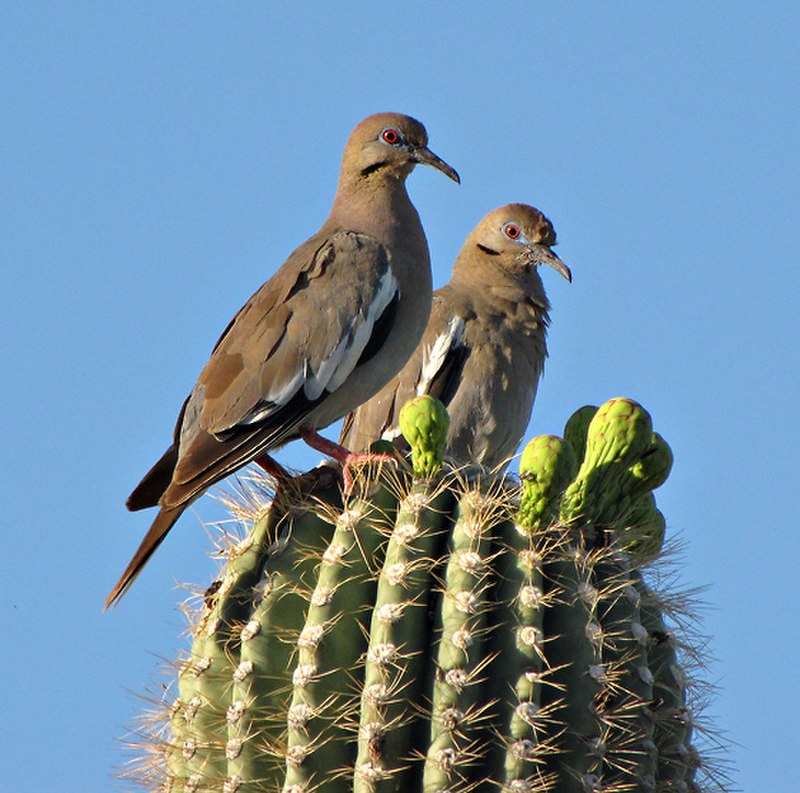
The White-winged Dove is an impressive bird with a large body and wingspan. Its distinctive feature is the white edge on its wings, which makes it easily recognizable when in flight.
It has blue eyerings, red eyes and gray plumage, while juveniles are duller in coloration than adults.
This dove species inhabits areas from Southwestern United States through Mexico to Central America as well as Caribbean islands.
They usually live close to human settlements or cities but can also be found in agricultural fields feeding on grains like corn or wheat seeds left by farmers after harvest season ends.
In their natural habitat they feed primarily on insects, fruits and small plants such as certain cacti species.Scientific classification:
| Kingdom | Animalia |
| Phylum | Chordata |
| Class | Aves |
| Order | Columbiformes |
| Family | Columbidae |
| Genus | Zenaida |
| Species | Z. asiatica |
Also Featured In: Phoenix Birds You Should Know, Birds that Live in the Deserts
5. Inca Dove
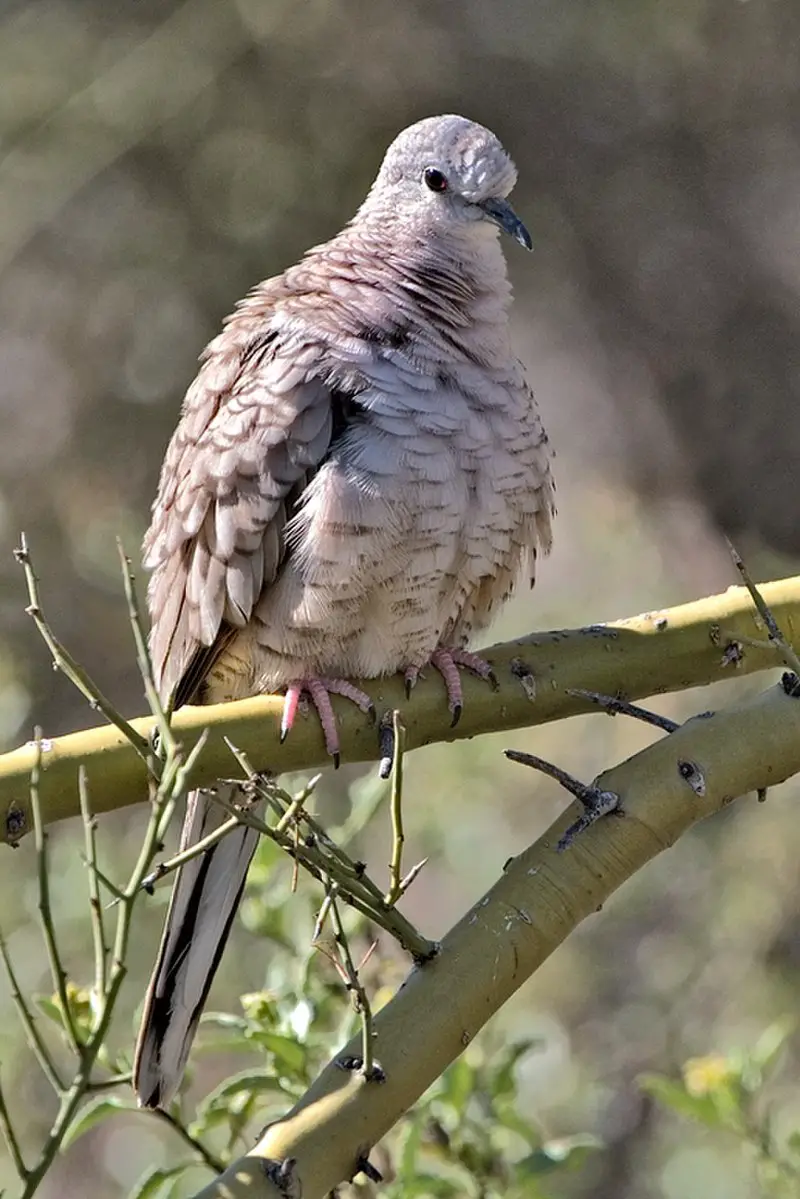
The Inca Dove is a small, slender bird found in the New World. It has an average length of 16.5–23 cm and weighs about 30-58 gm. Its wingspan measures around 28.5cm but can reach up to 32cm at max.
The body of this dove is grayish brown with feathers that are rounded off tips giving it a soft look overall.
This species was first described by French surgeon and naturalist René Lesson back in 1847 and since then have been living happily all over North America from Mexico through Texas to South Dakota, Kansas as well as parts of Arizona among others regions too.Scientific classification:
| Kingdom | Animalia |
| Phylum | Chordata |
| Class | Aves |
| Order | Columbiformes |
| Family | Columbidae |
| Genus | Columbina |
| Species | C. inca |
Also Featured In: Birds You’ll Find in Sonoran, Birds that Live in Jalisco Birds
6. White-Faced Ibis
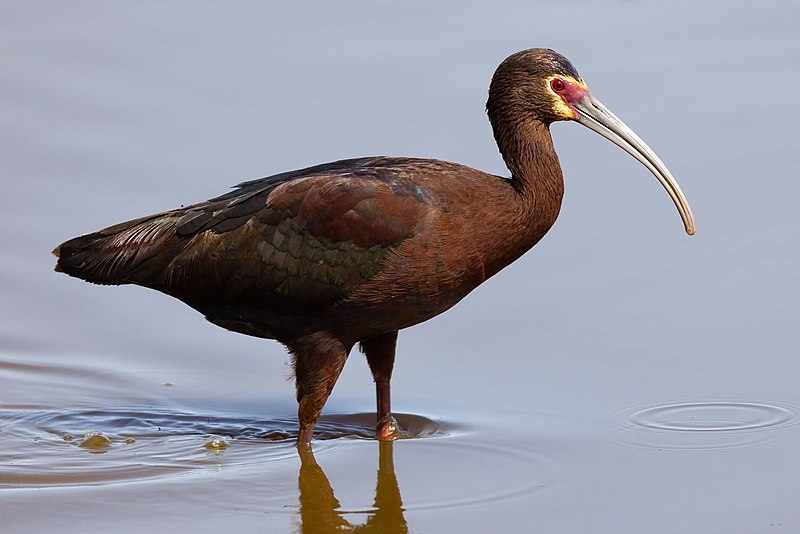
The White-faced Ibis is a species of wading bird belonging to the ibis family. It breeds in marshes, nesting on low trees or bushes.
The breeding range for this species stretches from western United States south through Mexico, and from southeastern Brazil and Bolivia all the way down to central Argentina and along the coast of Chile.
Its wintering grounds include coastal California, northern Arizona, New Mexico as well as Central America; it also occasionally occurs further north than usual due to favorable conditions.
This beautiful bird has white plumage with bronze wings that shine when seen under sunlight. Furthermore, its head is adorned by an unmistakable white face patch which gives it its name—White-faced Ibis.Scientific classification:
| Kingdom | Animalia |
| Phylum | Chordata |
| Class | Aves |
| Order | Pelecaniformes |
| Family | Threskiornithidae |
| Genus | Plegadis |
| Species | P. chihi |
Also Featured In: Water Birds Live around Us, Common Birds of Antelope Island State Park
7. Long-Billed Dowitcher
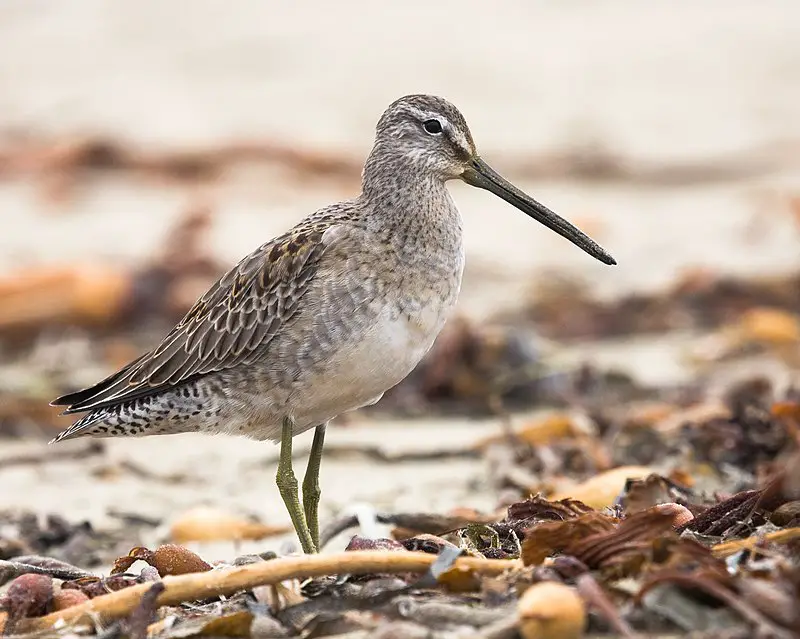
The Long-billed Dowitcher is a beautiful shorebird with an unmistakable long bill. During breeding season, they are characterized by their rufous head and underparts combined with a dark mottled back and large white upper rump only visible when in flight.
These birds can be found in freshwater habitats all over the world, where they forage underwater using their long bills to seek out aquatic invertebrates such as insects or small crustaceans.
They also feed on plant material like seeds and berries during times of scarcity.
The Long-billed Dowitcher is an important species for ecological balance due to its unique feeding habits that help control populations of certain insect pests, which makes it one of the most valuable bird species around us.Scientific classification:
| Kingdom | Animalia |
| Phylum | Chordata |
| Class | Aves |
| Order | Charadriiformes |
| Family | Scolopacidae |
| Genus | Limnodromus |
| Species | L. scolopaceus |
Also Featured In: Birds in Calgary You’ll Love to See, Birds of Norfolk
8. Ringed Kingfisher
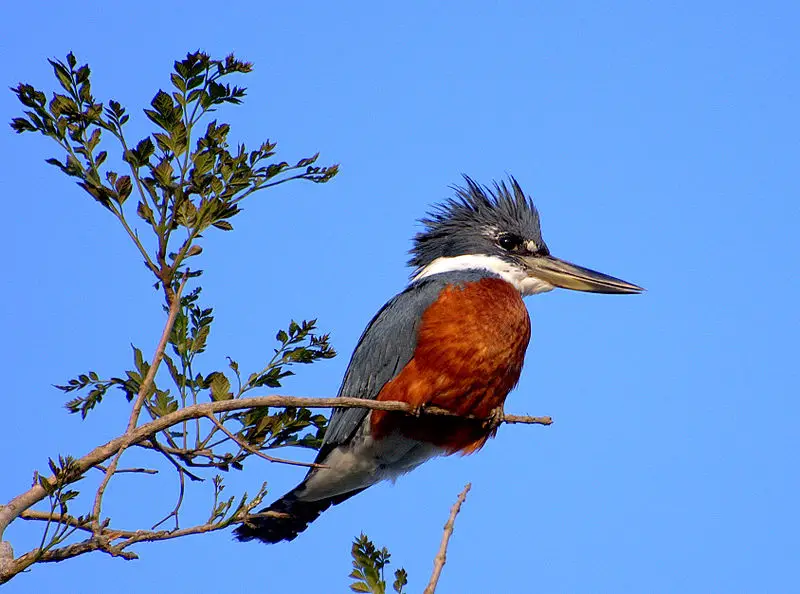
The Ringed Kingfisher is a large, vibrant bird that can be easily noticed by its loud call. It’s found in tropical regions from the lower Rio Grande Valley of southeastern Texas to Central America and even as far south as Tierra del Fuego.
This ground-dwelling species prefers to inhabit open areas near water bodies like streams, rivers and lakes which provide them with plenty of food such as fish, amphibians, crustaceans and insects.
In 1888 it was first identified by ornithologist Frank Chapman who noted its distinct ring pattern on the breast area.
The upperparts are dark blue while underneath they have white spots around their neck and belly region along with pale brown wings tipped in black stripes making this species quite unique among other kingfishers.
They may look intimidating but these birds actually play an important role for humans since they help control insect populations thus helping maintain a healthy balance within our ecosystems.Scientific classification:
| Kingdom | Animalia |
| Phylum | Chordata |
| Class | Aves |
| Order | Coraciiformes |
| Family | Alcedinidae |
| Subfamily | Cerylinae |
| Genus | Megaceryle |
| Species | M. torquata |
Also Featured In: Common Birds in Colombia, Birds that Live in Guyana
9. Groove-Billed Ani
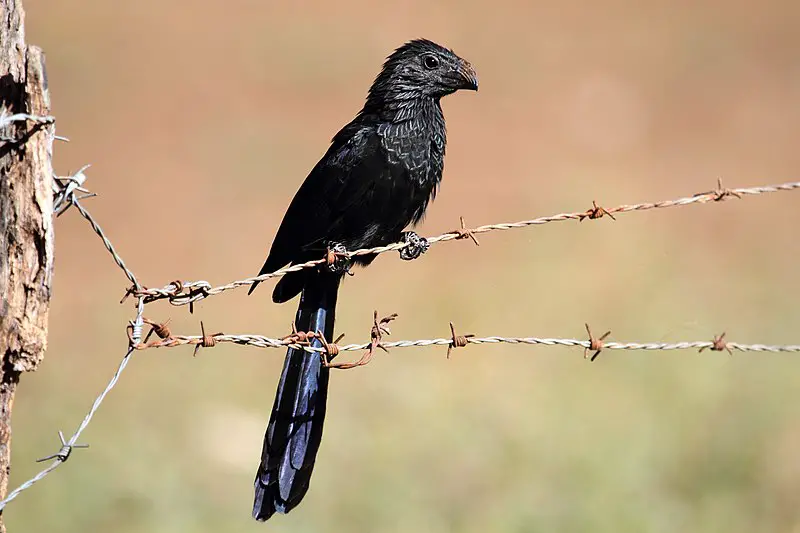
The Groove-billed ani is a tropical bird belonging to the cuckoo family. It has a long tail and large, curved beak.
This species can be found in many parts of Central America, from southern Texas to northern Colombia and Venezuela, as well as coastal Ecuador and Peru.
In some places it may retreat during colder months but overall they are considered resident birds throughout their range.
They prefer open woodlands near water sources like mangroves or swamps where there plenty of insects for them to feed on such as grasshoppers and beetles.
The beautiful coloration of this species ranges from blackish brown with orange spots on its wings that give way to bright blue feathers at the end of its tail making it quite striking.Scientific classification:
| Kingdom | Animalia |
| Phylum | Chordata |
| Class | Aves |
| Order | Cuculiformes |
| Family | Cuculidae |
| Genus | Crotophaga |
| Species | C. sulcirostris |
Also Featured In: Most Unique Birds in Peru, Birds that Live in the Grand Canyon National Park
10. Green Kingfisher
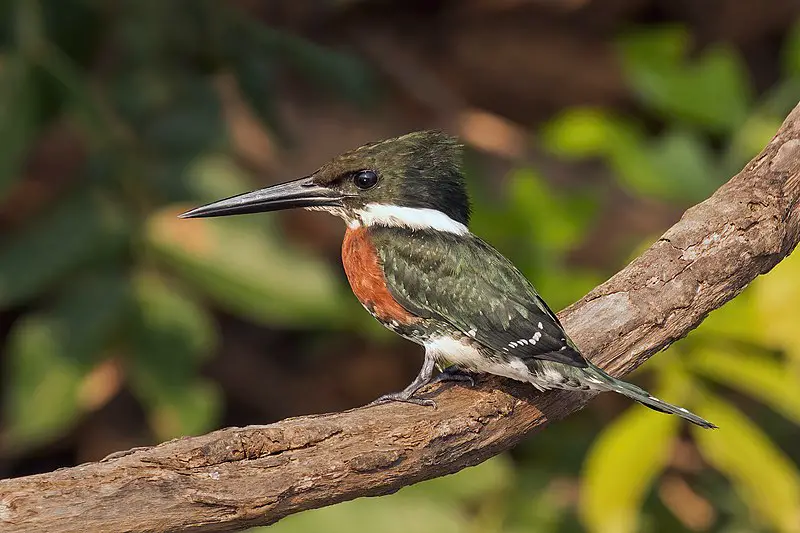
The Green Kingfisher is an incredibly vibrant bird, boasting a bright green plumage and long beak.
It can primarily be found throughout Central America, in most South American countries except Chile, as well as Texas in the United States and Trinidad & Tobago.
This species of water kingfisher belongs to subfamily Cerylinaeof family Alcedinidae which was first described by German naturalist Johann Friedrich Gmeiner back in 1788.
The Green Kingfishers are known for their active hunting habits where they perch above shallow waters looking out for prey such as small fish or crustaceans before diving down rapidly into the water with a loud splash.Scientific classification:
| Kingdom | Animalia |
| Phylum | Chordata |
| Class | Aves |
| Order | Coraciiformes |
| Family | Alcedinidae |
| Subfamily | Cerylinae |
| Genus | Chloroceryle |
| Species | C. americana |
Also Featured In: Most Common Birds Found in Chile, Green Birds in That Live in Texas
11. Lineated Woodpecker
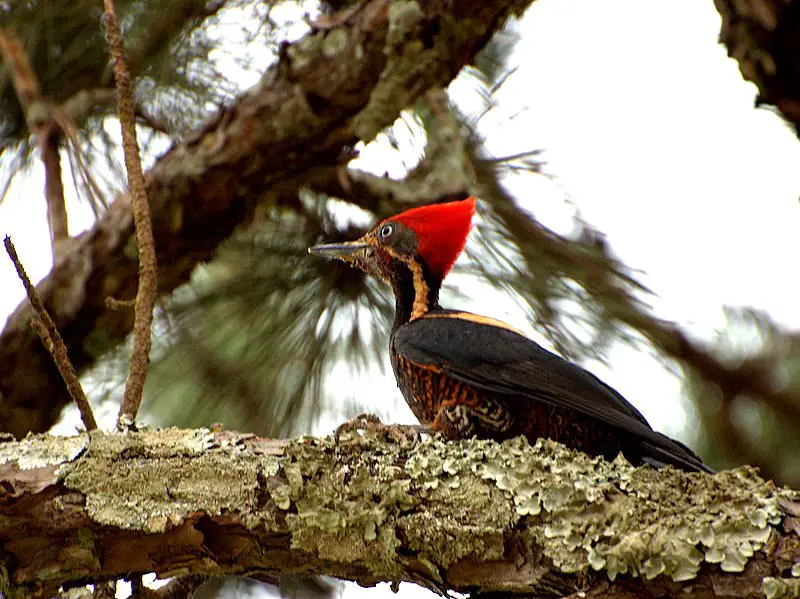
The Lineated Woodpecker is a large bird found in Mexico, Argentina and the Caribbean. It was first described by French zoologist Mathurin Jacques Brisson in 1760 with the name Le pic noir.
This species has black upperparts, wings and tail with white stripes running along its back and head; it also features red marks on its forehead as well as on both sides of its neck.
Its underparts are mostly greyish-white while its bill is yellowish-black and slightly hooked at the end.
These birds feed mainly on insects but can sometimes be seen foraging for fruits or tree sap too.
They nest inside cavities usually made from dead trees which they excavate themselves using their strong bills perfect for drilling into woody material easily.
All in all, these beautiful birds make an interesting addition to any backyard garden.Scientific classification:
| Kingdom | Animalia |
| Phylum | Chordata |
| Class | Aves |
| Order | Piciformes |
| Family | Picidae |
| Genus | Dryocopus |
| Species | D. lineatus |
Also Featured In: Birds of Bolivia,
12. Northern Jacana
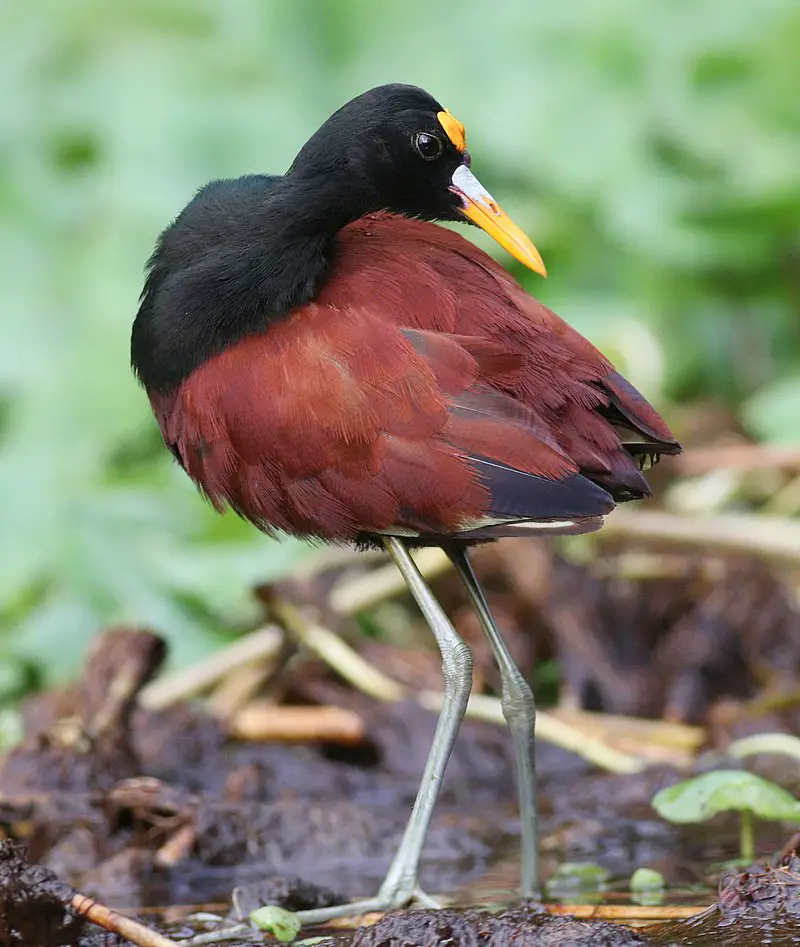
The Northern Jacana is a wading bird native to Mexico, Panama, Cuba, Jamaica and Hispaniola. It can also be found in Texas as a resident breeder or on rare occasions in Arizona as a vagrant.
This species of wetland birds are easily identified by their immense size and large feet with long toes that help them walk atop floating vegetation while searching for food.
Their upperparts have black feathers streaked with white whilst its underparts display brown plumage marked by yellowish spots near the wingtips.
They feed primarily on insects but will also eat other aquatic invertebrates like crustaceans or mollusks when available.
The female builds an untidy nest made from leaves close to water so she can quickly escape predators if needed.Scientific classification:
| Kingdom | Animalia |
| Phylum | Chordata |
| Class | Aves |
| Order | Charadriiformes |
| Family | Jacanidae |
| Genus | Jacana |
| Species | J. spinosa |
Also Featured In: Dominican Republic birds, Birds That You’ll Find in Hispaniola
13. American Pygmy Kingfisher
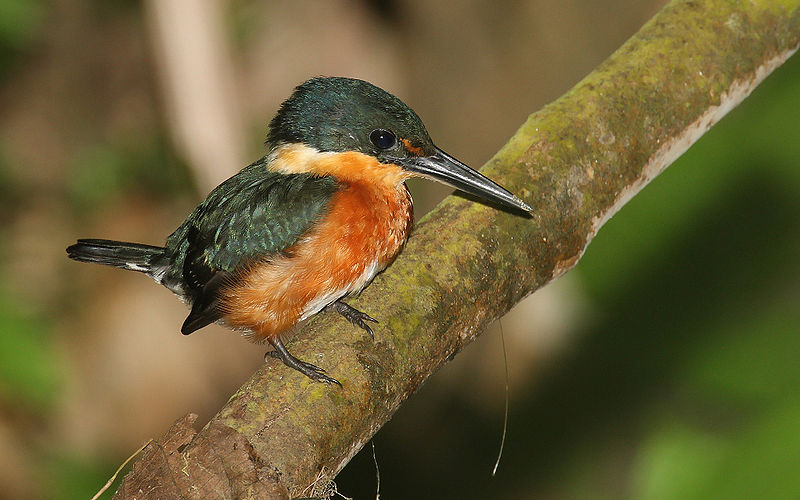
The American pygmy kingfisher is a species of water bird belonging to the subfamily Cerylinae and family Alcedinidae.
This small, colourful kingfisher can be found in tropical regions from Mexico southwards through Central America and into every mainland country in South America excluding Chile and Uruguay.
It also occurs on Trinidad Island. The first formal description of this beautiful creature was made by German naturalist Johann Baptist von Spix as part of his Avium Species Novae series published back in 1824.
Its scientific name Chloroceryle aenea refers to its bronze-green upperparts which contrast with its white undersides – Aeneas being an Ancient Greek term for ‘bronze’ or ‘copper’.
They are usually solitary birds living near bodies of freshwater where they feed mainly on fish, crustaceans, insects and their larvae.Scientific classification:
| Kingdom | Animalia |
| Phylum | Chordata |
| Class | Aves |
| Order | Coraciiformes |
| Family | Alcedinidae |
| Subfamily | Cerylinae |
| Genus | Chloroceryle |
| Species | C. aenea |
Also Featured In: Birds of Honduras,
14. Turquoise-Browed Motmot
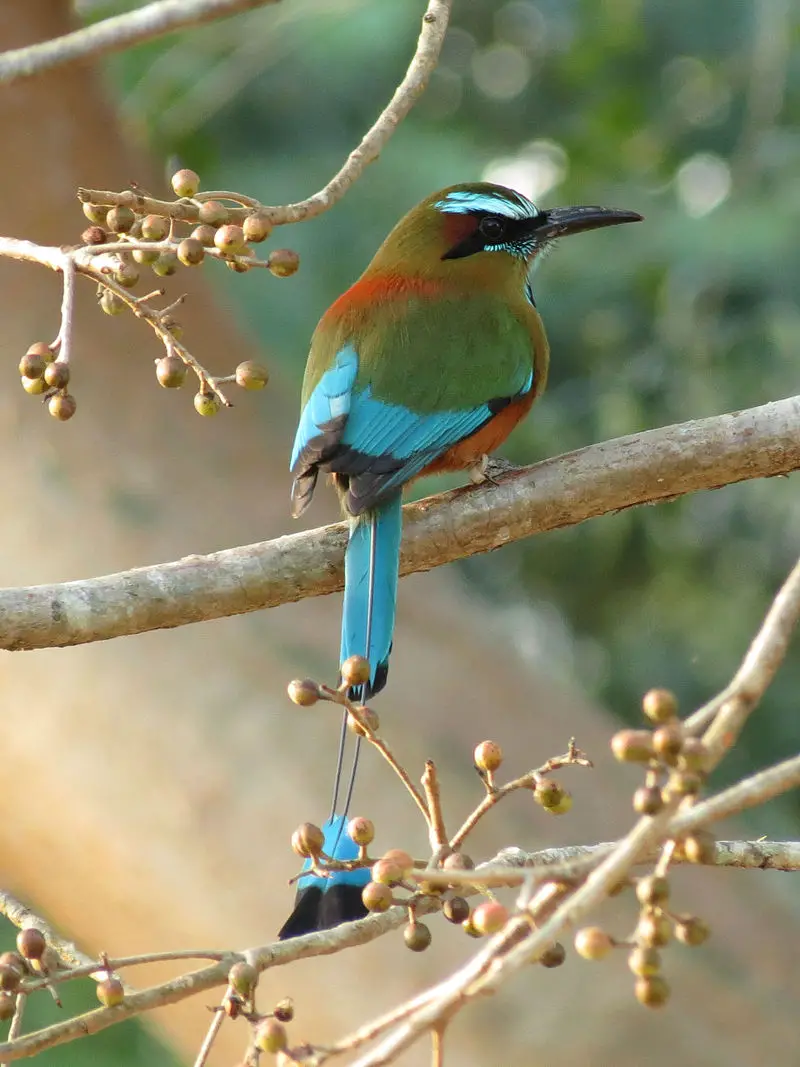
The turquoise-browed motmot is a beautiful bird of the Momotidae family. It can be found in central America from south east Mexico to Costa Rica, where it is common and not considered threatened.
This species enjoys living in open habitats such as forest edges, gallery forests or scrubland.
They are more visible than other Motmots due to their large size and bright colouration which includes an iridescent blue back and yellowish chest with black spots on its throat feathers.
Turquoise-browed motmots possess unique features that set them apart; they have two long tail feathers which dangle behind them while flying like streamers, hence earning themselves the nickname “the flying orchestra”.
In addition they are known for their loud calls during mating season – making them easily recognizable.Scientific classification:
| Kingdom | Animalia |
| Phylum | Chordata |
| Class | Aves |
| Order | Coraciiformes |
| Family | Momotidae |
| Genus | Eumomota P.L. Sclater, 1858 |
| Species | E. superciliosa |
Also Featured In: Common Latin America Birds,
15. Great Curassow
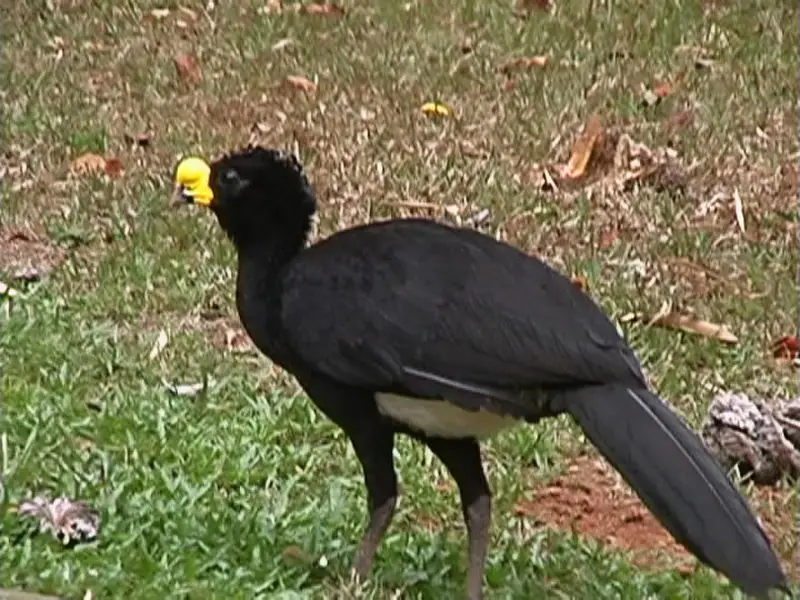
The Great Curassow is an impressive bird, found in the Neotropical rainforests. Males are easily identified by their black color and yellow beaks, while females come in three distinct morphs: barred, rufous or black.
These birds have a pheasant-like shape and can form small groups when foraging on the ground for fruits.
The range of this species extends from eastern Mexico to western Colombia and northwestern Ecuador; however they can also be seen in other regions like Costa Rica where conservation efforts are helping with population growth.
While not considered endangered yet, destruction of its natural habitat does pose threats to these majestic creatures if it’s not properly managed soon enough.Scientific classification:
| Kingdom | Animalia |
| Phylum | Chordata |
| Class | Aves |
| Order | Galliformes |
| Family | Cracidae |
| Genus | Crax |
| Species | C. rubra |
Also Featured In: Most Common Birds in South America Birds,
16. White-Fronted Amazon
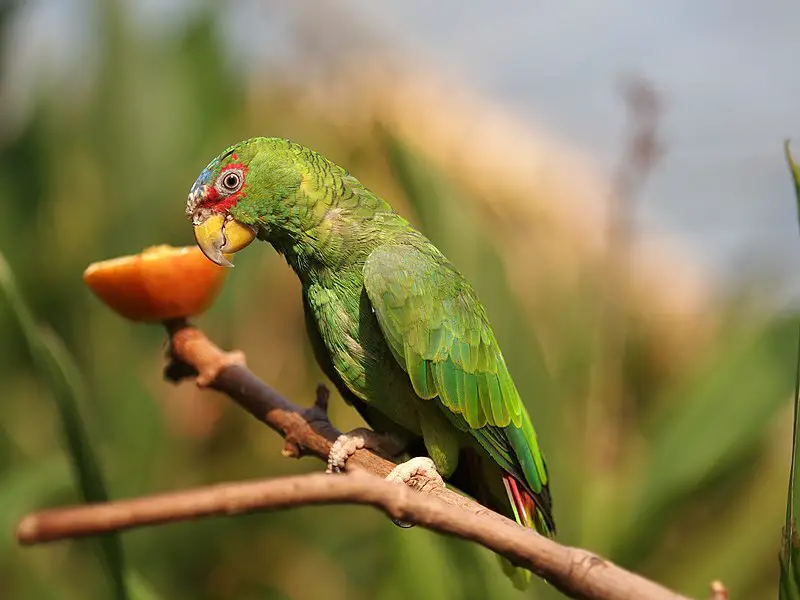
The white-fronted amazon is a Central American parrot that stands out for its bright colouring and ability to imitate around 40 different sounds.
It has an average life span of about 40 years, making it one of the longest living parrots in existence.
Despite being the smallest species among large parrots, measuring 25cm long, this bird still possesses strong vocal chords which can be heard from great distances.
They have beautiful yellow heads with distinctive white patches on their forehead and grey feathers covering their wings and tail.
These birds are very social animals who live in pairs or family groups within tropical rainforests and wetlands where they feed mostly on seeds found in trees such as palms.Scientific classification:
| Kingdom | Animalia |
| Phylum | Chordata |
| Class | Aves |
| Order | Psittaciformes |
| Family | Psittacidae |
| Genus | Amazona |
| Species | A. albifrons |
17. Chestnut-Colored Woodpecker
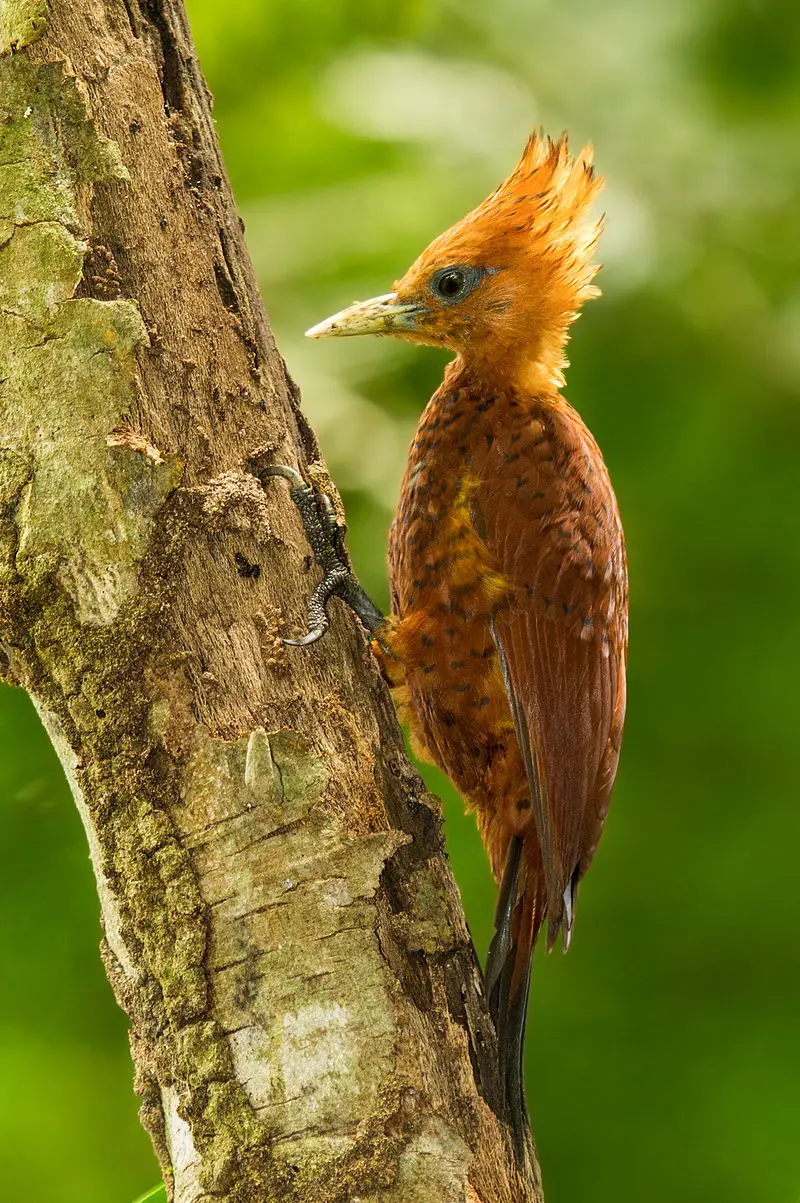
The Chestnut-colored woodpecker is a stunning bird found in Central America. It has an unmistakable rich chestnut color, with intricate V-shaped black markings on its back and wings.
Its head is creamy brown, topped with a crest of feathers and it’s bill has a greenish ivory hue to it. The male also sports broader moustache stripes than the female counterpart, making them easy to tell apart.
This species can be found inhabiting subtropical or tropical moist lowland forests and primarily feeds off insects such as ants, beetles etc., which they capture by drumming rapidly on dead branches or tree trunks using their long bills.
They are very territorial birds but will occasionally flock together when food sources become scarce during dry weather spells .Scientific classification:
| Kingdom | Animalia |
| Phylum | Chordata |
| Class | Aves |
| Order | Piciformes |
| Family | Picidae |
| Genus | Celeus |
| Species | C. castaneus |
18. Great Kiskadee
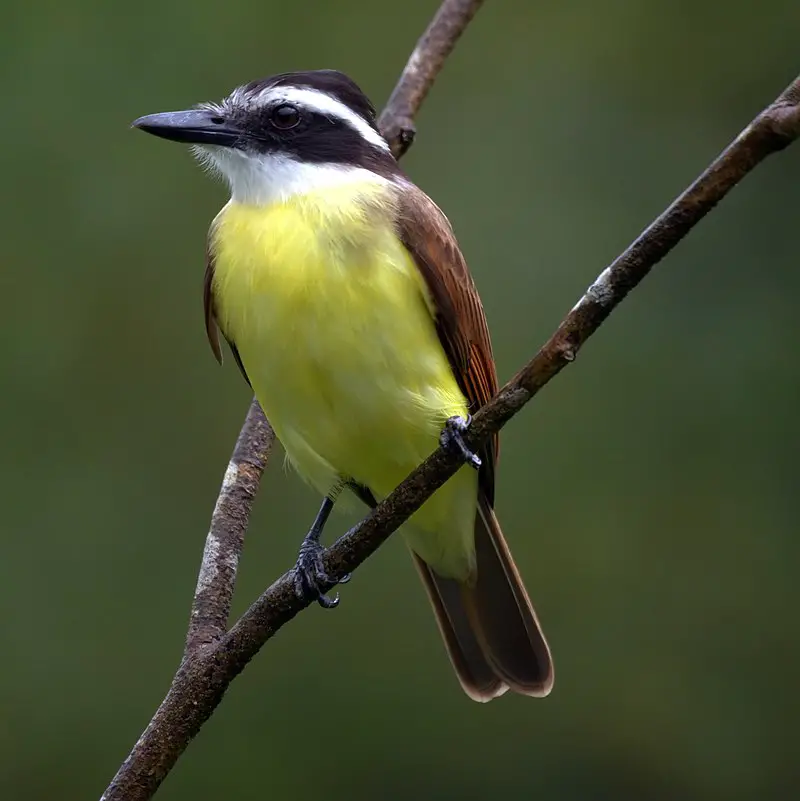
The Great Kiskadee is a passerine bird belonging to the Tyrant Flycatcher family.
It has an unmistakable yellow and black plumage, making it easily recognizable in its native habitats of Belize, Texas, Argentina and Brazil where it is known as Bem-te-vi or Benteveo respectively.
The species inhabits open woodland with some tall trees such as cultivation areas and other places surrounding human dwellings.
This adaptable bird feeds mainly on insects but also consumes fruit for energy when needed.
Its call resembles laughter which adds to its charm among avid nature watchers who are always delighted by their presence.
A unique feature that sets this species apart from others is that they can imitate songs of other birds accurately too.Scientific classification:
| Kingdom | Animalia |
| Phylum | Chordata |
| Class | Aves |
| Order | Passeriformes |
| Family | Tyrannidae |
| Genus | Pitangus Swainson, 1827 |
| Species | P. sulphuratus |
Also Featured In: Most Common Birds In Paraguay, Spring Birds that Live around Us
19. Bare-Throated Tiger Heron
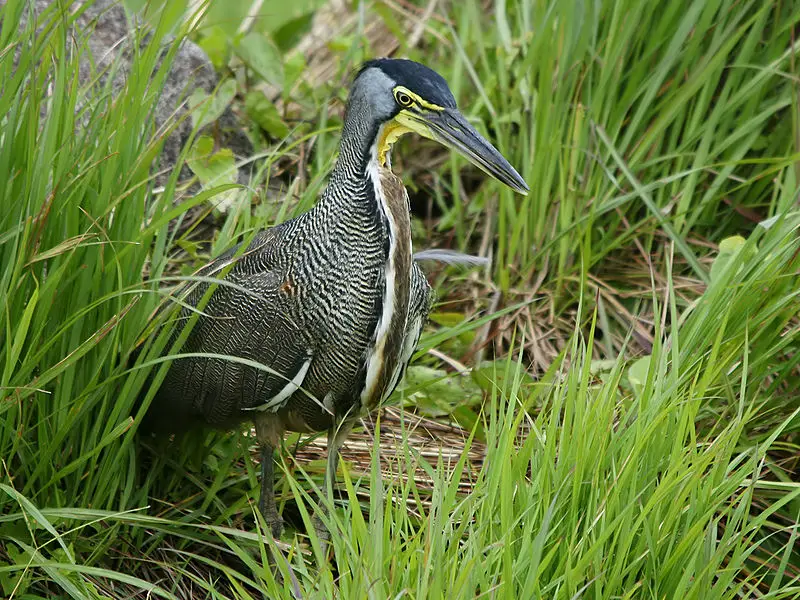
The Bare-throated Tiger Heron is an impressive wading bird belonging to the heron family, Ardeidae.
It has a length of 80 cm and weighs 1,200 grams. Found from Mexico to northwestern Colombia with one recorded sighting from the United States in Texas, it prefers more open habitats such as river and lake banks than other Tigrisoma herons.
Its plumage is blackish above with white spots on its back while its lower parts are chestnut brown or rufous in coloration.
The head and throat have bare yellow skin that can turn bright red when alarmed or during courtship displays.
Additionally, these birds feed mainly on fish but also eat amphibians, reptiles and aquatic insects which they capture by standing still before suddenly snatching them up.Scientific classification:
| Kingdom | Animalia |
| Phylum | Chordata |
| Class | Aves |
| Order | Pelecaniformes |
| Family | Ardeidae |
| Genus | Tigrisoma |
| Species | T. mexicanum |
Also Featured In: Colorful Birds of Nicaragua, Puerto Vallarta Birds You Should Know
20. Golden-Fronted Woodpecker
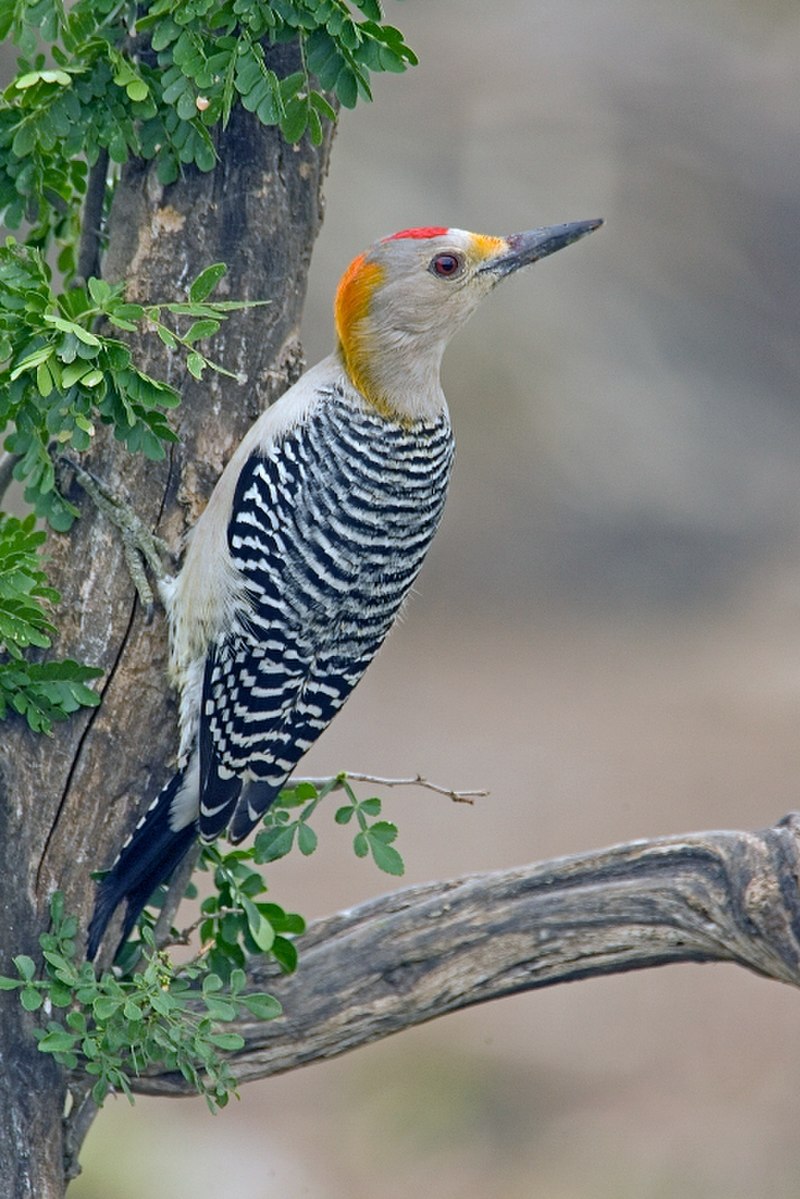
The golden-fronted woodpecker is an attractive species that inhabits mesquite, riparian woodlands and tropical rainforests across the southern United States, Mexico, Belize Guatemala El Salvador Honduras and northern Nicaragua.
It has a unique appearance with its yellow forehead patch contrasting against its grey back feathers.
These birds eat insects as well as fruits of many trees including cactus fruit in some areas.
They are known to make nests in cavities they excavate from dead or dying trees or utility poles which helps disperse essential nutrients into the ecosystem.
Their loud calls can be heard during breeding season providing bird watchers with a memorable experience.Scientific classification:
| Kingdom | Animalia |
| Phylum | Chordata |
| Class | Aves |
| Order | Piciformes |
| Family | Picidae |
| Genus | Melanerpes |
| Species | M. aurifrons |
Also Featured In: El Salvador Birds, Native Birds in Lower Rio Grande Valley
21. Altamira Oriole

The Altamira oriole is a New World species found in subtropical lowlands from the Mexican Gulf Coast to northern Central America, and inland as well. It was only recently spotted in southern Texas since 1939.
This bird stands out among its genus for being the largest at 25cm (9.8in) and 56g (2oz). Its preferred habitat is open woodland where it builds nests made of plant fibers and animal hair lined with grasses or mosses.
Adults have black heads, wings and tails while their chests are orange-yellow with white markings on each side; juveniles display more yellowish plumage than adults do.
They feed mainly on insects but also occasionally eat fruits or nectar depending on what’s available during certain seasonsScientific classification:
| Kingdom | Animalia |
| Phylum | Chordata |
| Class | Aves |
| Order | Passeriformes |
| Family | Icteridae |
| Genus | Icterus |
| Species | I. gularis |
Also Featured In: Yellow Birds that Live in Yucatan, Black Birds that Live around United States of America
22. Pale-Vented Pigeon
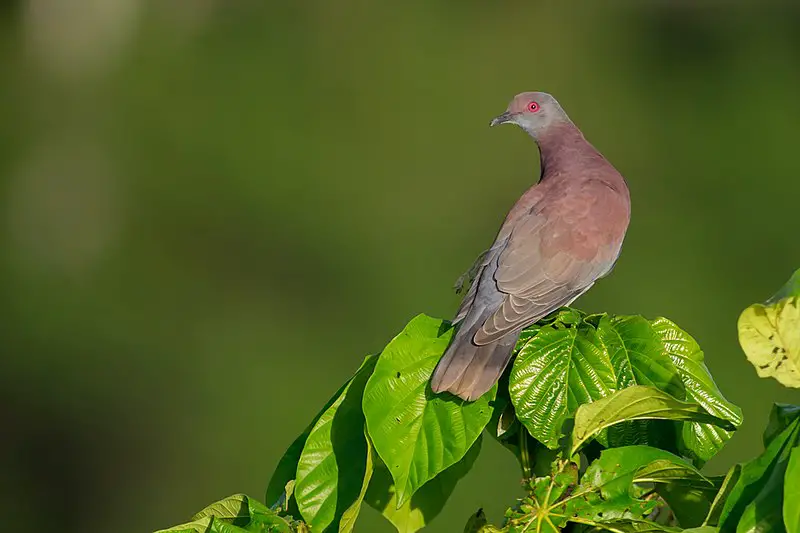
The Pale-vented pigeon is a large bird found in the tropical Americas, and belong to an evolutionary radiation of Patagioenas.
It has a grey hue all over its body, even males usually lack any iridescent colors in their plumage.
They have small heads with red eyes and short bills, while their wings are broad but pointed at the tips. Their legs are dark pink and they feed mainly on fruits from trees or shrubs.
These birds live in pairs or families throughout lightly wooded areas like pastures where they can find food easily.
However during winter months they tend to form larger flocks together for protection against predators as well as cold weather conditions.Scientific classification:
| Kingdom | Animalia |
| Phylum | Chordata |
| Class | Aves |
| Order | Columbiformes |
| Family | Columbidae |
| Genus | Patagioenas |
| Species | P. cayennensis |
Also Featured In: Guyana birds,
23. Stilt Sandpiper
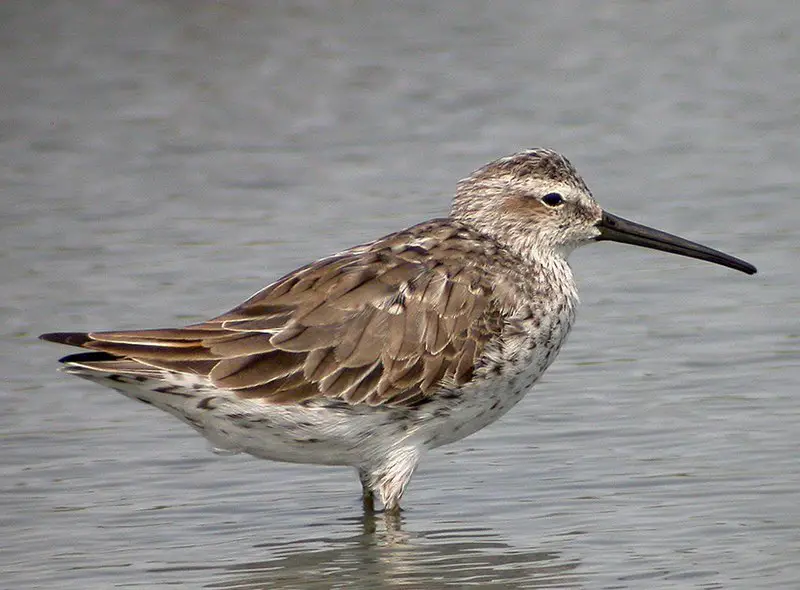
The Stilt Sandpiper (Calidris himantopus) is a small shorebird with ancient Greek origins. It has grey-coloured feathers, and its scientific name is derived from the terms “strap foot” or “thong foot”.
This bird bears some resemblance to smaller calidrid sandpipers, also known as ‘stints’. Through recent DNA sequence information, it was found that this species of birds are closely related to other wading shorebirds such as curlews and godwits.
They can usually be seen along the edges of rivers and creeks in shallow waters where they feed on aquatic insects like beetles, flies, mayflies etc., which makes them an important part of their ecosystem’s food chain.
The stilt sandpiper population appears to have been stable over time but further research needs to be done in order for us to understand more about this unique species.Scientific classification:
| Kingdom | Animalia |
| Phylum | Chordata |
| Class | Aves |
| Order | Charadriiformes |
| Family | Scolopacidae |
| Genus | Calidris |
| Species | C. himantopus |
Also Featured In: Saint Lucia Birds, British Virgin Islands Birds You Need to See
24. Baird’s Sandpiper
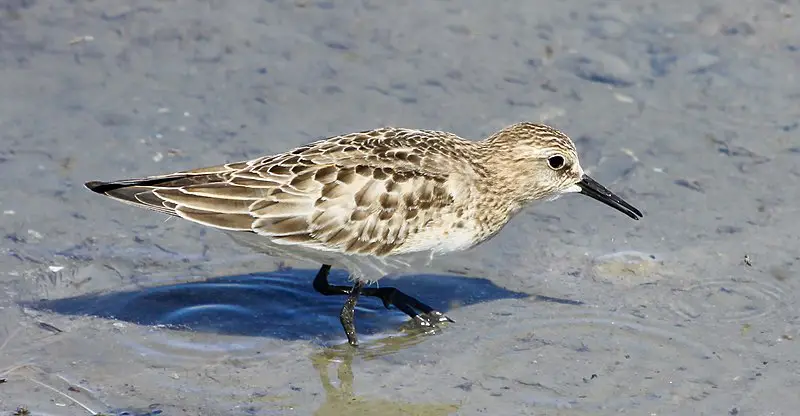
Baird’s sandpiper is a small shorebird belonging to the Calidris genus. It has grey feathers and generally inhabits waterside locations, making it highly visible in its natural environment.
This species was named after Spencer Fullerton Baird, a 19th century American ornithologist who worked with birds from across North America.
The bird is relatively widespread but may be declining in some areas due to human activity such as habitat destruction or pollution of coastal wetlands where they often reside.
As an adaptable species however, Baird’s sandpipers have been observed foraging on dry land far away from water sources during migration periods when food resources are scarce at their home grounds near waterways.Scientific classification:
| Kingdom | Animalia |
| Phylum | Chordata |
| Class | Aves |
| Order | Charadriiformes |
| Family | Scolopacidae |
| Genus | Calidris |
| Species | C. bairdii |
Also Featured In: Grenada Birds, Birds that Live in Greenland
25. Least Grebe
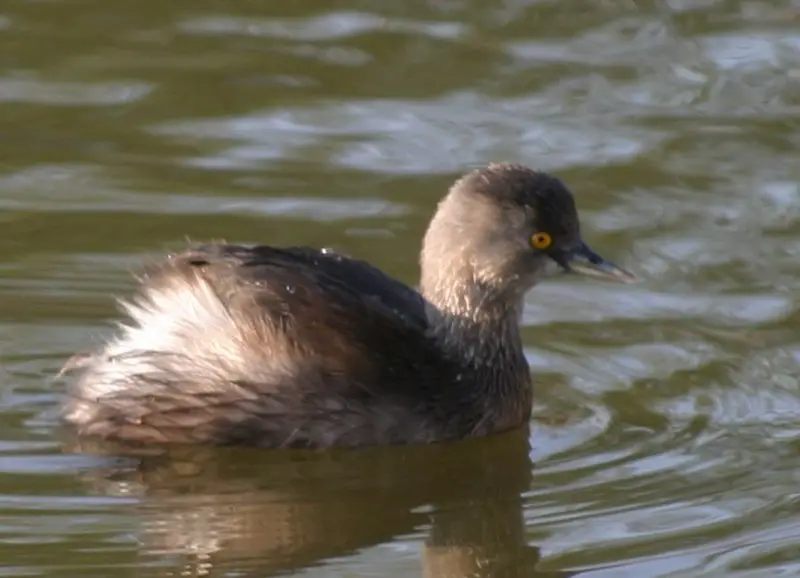
The Least Grebe is the smallest member of the grebe family and can be found in North, Central and South America. It measures around 21-27 cm long with a weight of 112-180 g.
Its range extends from southwestern United States to Argentina as well as Trinidad, Tobago, Bahamas and Greater Antilles.
The bird has an interesting plumage which varies depending on its subspecies; it may have dark brown upperparts or rusty back feathers along with whitish underparts having buff spots near the throat area.
In addition to this its neck has black streaks while head may be grey or reddish brown.
This species feeds mainly on small aquatic invertebrates like insects larvae , crustaceans etc., but also eats fish occasionally when available.
Breeding season for least grebes occurs during summer months between April -July where they build floating nests among reeds in shallow water bodiesScientific classification:
| Kingdom | Animalia |
| Phylum | Chordata |
| Class | Aves |
| Order | Podicipediformes |
| Family | Podicipedidae |
| Genus | Tachybaptus |
| Species | T. dominicus |
Also Featured In: Cayman Islands birds,
26. White-Tipped Dove
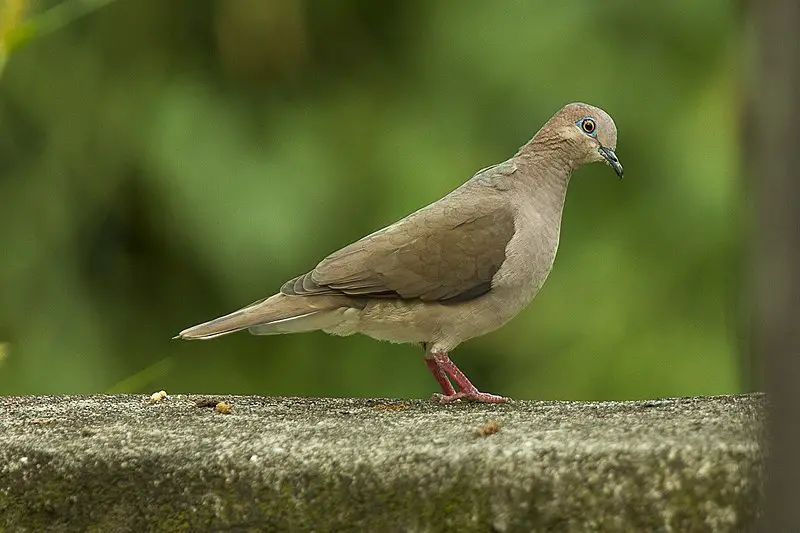
The White-tipped Dove is a majestic bird found in tropical areas of the New World, from southern Texas and Mexico all the way to western Peru and Argentina.
It carries with it an interesting scientific name: Leptotila verreauxi, named after French naturalists Jules and Edouard Verraux.
This species also breeds on offshore islands along northern South America, including Trinidad.
It has distinctive white tips on its wings which makes them easily identifiable while they are flying as well as when perched.
They have grayish brown feathers overall that helps camouflage them amongst trees or foliage making them difficult to spot otherwise.
The males tend to be slightly larger than females but other than that there isn’t much difference between their appearance aside from courtship rituals where both sexes will bow together for recognition before mating season starts.Scientific classification:
| Kingdom | Animalia |
| Phylum | Chordata |
| Class | Aves |
| Order | Columbiformes |
| Family | Columbidae |
| Genus | Leptotila |
| Species | L. verreauxi |
Also Featured In: Doves Birds, Birds You’ll Find in South Texas
27. Snail Kite
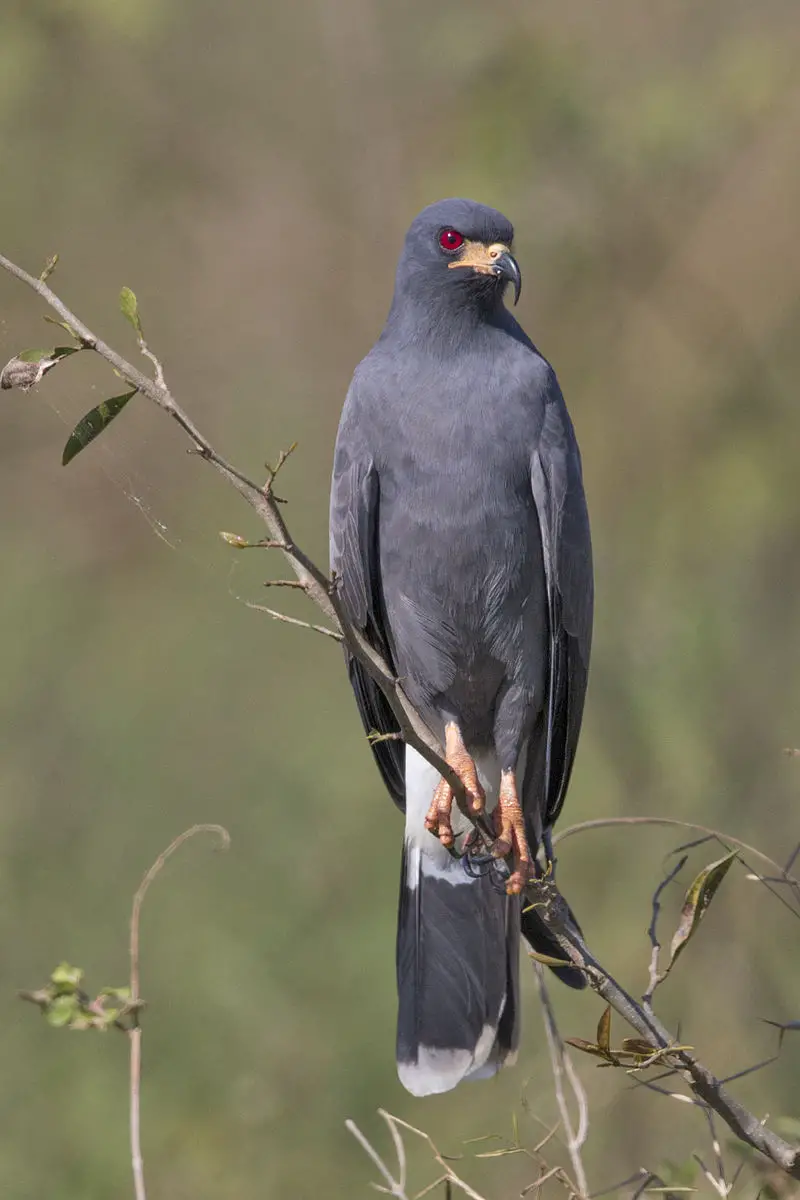
The Snail Kite is a medium sized bird of prey belonging to the Accipitridae family, which also includes eagles, hawks and Old World vultures.
It’s relative, the Slender-billed Kite was once part of this family but now belongs in Helicolestes.
The Snail Kite measures around 36 to 48 cm long with males being slightly smaller than females.
They can be identified by their yellow eyes, grey wings and reddish brown head feathers as well as their hooked bill used for catching food such as snails – hence its name.
These birds are mainly found near rivers or wetlands in tropical climates where they feed on apple snail shells filled with soft fleshy parts inside them.
This species is endangered due to habitat destruction caused by human development so conservation efforts need to be taken if we want these beautiful creatures around for many more years.Scientific classification:
| Kingdom | Animalia |
| Phylum | Chordata |
| Class | Aves |
| Order | Accipitriformes |
| Family | Accipitridae |
| Genus | Rostrhamus Lesson, 1830 |
| Species | R. sociabilis |
Also Featured In: Florida Birds, Everglades Birds
28. Gray Hawk
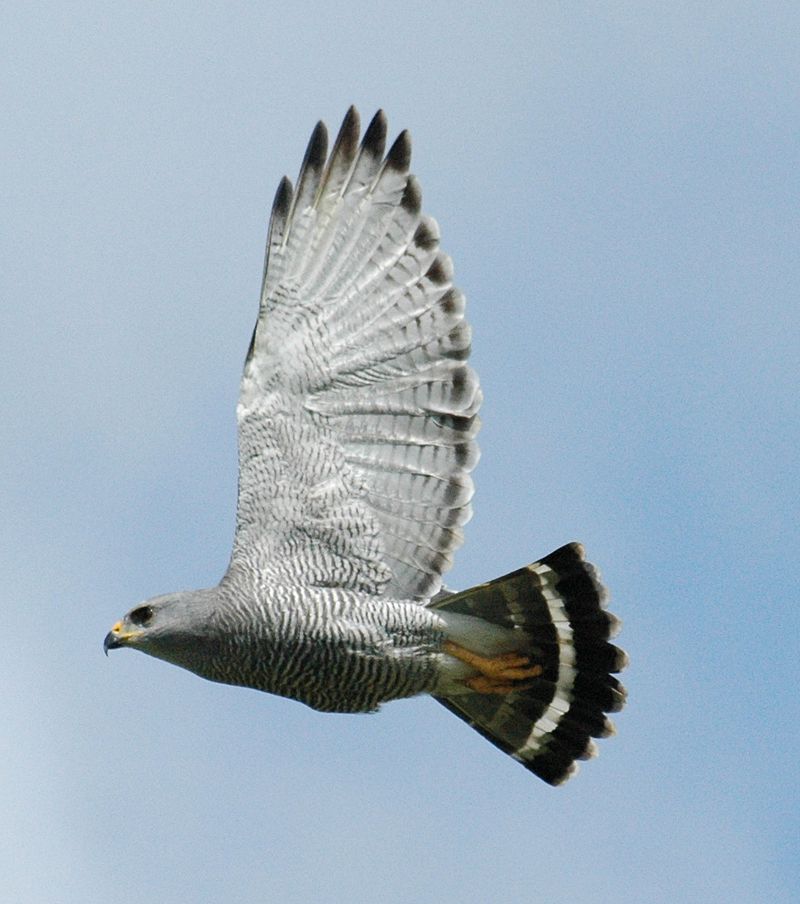
The Gray Hawk is a small raptor that inhabits open country and forest edges, ranging from Costa Rica up to the southwestern United States.
It has a length of 18 to 24 inches and is easily identifiable by its pale grey upperparts, with black-and-white barred tail feathers.
Its underparts are white or light buffy in color, with dark streaks on its breast. This species feeds mainly on rodents, lizards and insects but may also take larger prey such as snakes and other birds when needed.
The female builds an early nest made out of sticks during breeding season which usually begins around March through June depending on location.
Overall this hawk plays an important role in controlling rodent populations throughout it’s range making it ecologically beneficial for humans living nearby.Scientific classification:
| Kingdom | Animalia |
| Phylum | Chordata |
| Class | Aves |
| Order | Accipitriformes |
| Family | Accipitridae |
| Genus | Buteo |
| Species | B. plagiatus |
Also Featured In: birds of gray,
29. Plain Chachalaca
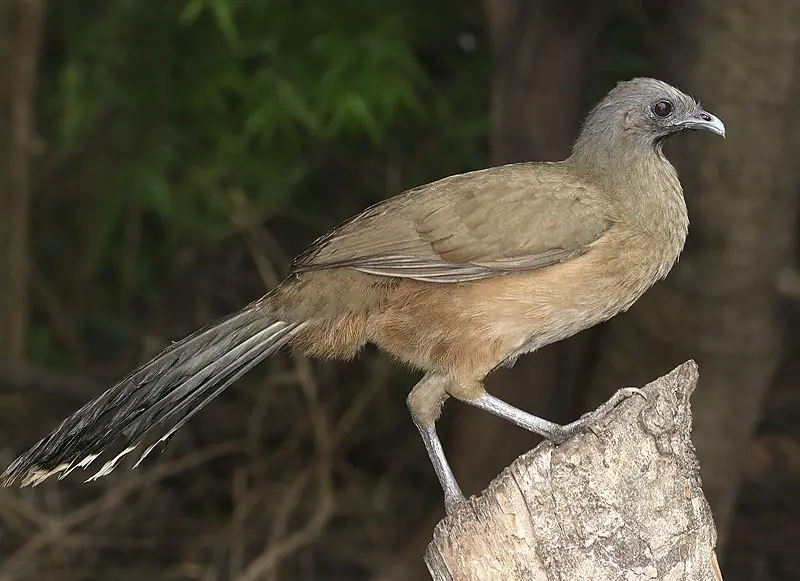
The plain chachalaca is a sizeable bird belonging to the Cracidae family, which includes guans and curassows. It can be found in tropical and subtropical regions from southernmost Texas in the US to northern Costa Rica.
This species breeds in various environments such as mezquital thickets and Pacific lowlands from Chiapas to Nicaragua.
Its distinct feature is the bare skin on its head and neck, which is bright red in color. The plain chachalaca is known for its hearty appetite and feeds primarily on fruits, seeds, and insects.
They are typically noisy birds, communicating with each other through loud vocalizations that can be heard up to one mile away.
Despite being hunted for meat in some areas, their overall population remains stable, and they are not currently considered a threatened species.Scientific classification:
| Kingdom | Animalia |
| Phylum | Chordata |
| Class | Aves |
| Order | Galliformes |
| Family | Cracidae |
| Genus | Ortalis |
| Species | O. vetula |
Also Featured In: Birds You’ll Find in the Rio Grande Valley, Most Common Birds of Nuevo Leon
30. Western Sandpiper
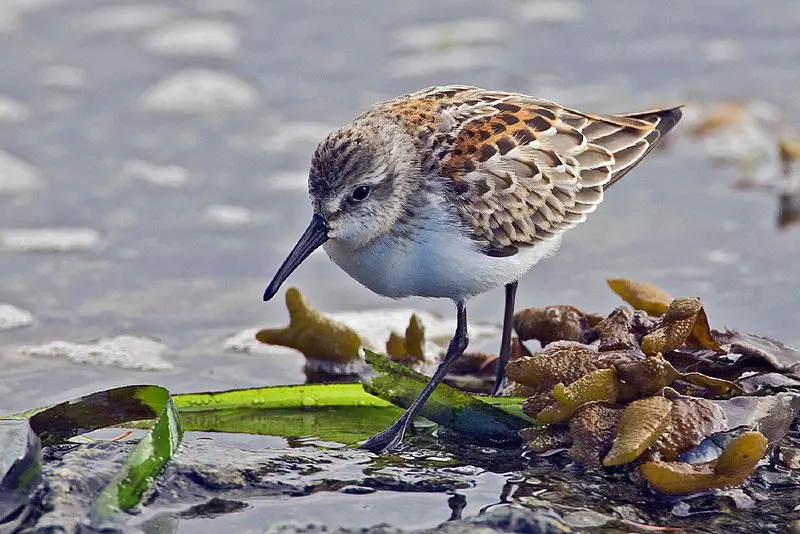
The Western sandpiper is a small shorebird found in North America. Its genus name, Kalidris, comes from the Ancient Greek term used by Aristotle for some grey-colored waterside birds.
The species name, mauri, is named after Italian botanist Ernesto Mauri. This species is one of the most abundant shorebirds in North America, with a population in the millions. Western sandpipers have dark legs and a short, straight bill.
They are often seen running quickly along the shorelines, probing the sand for insects and small crustaceans.
During breeding season, they nest in the Arctic tundra, and during migration, they can be found on mudflats and beaches along the Pacific Coast as well as inland shallow freshwater wetlands.Scientific classification:
| Kingdom | Animalia |
| Phylum | Chordata |
| Class | Aves |
| Order | Charadriiformes |
| Family | Scolopacidae |
| Genus | Calidris |
| Species | C. mauri |
Also Featured In: Birds that Live in San Francisco Bay Area, Estuaries Birds
31. Red-Billed Pigeon
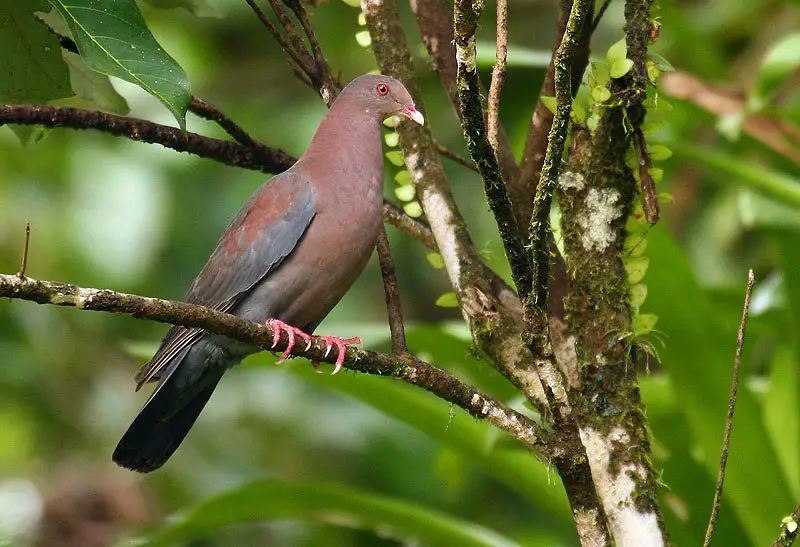
The Red-billed pigeon is a sturdy, large bird that inhabits southern Texas in the United States to the coasts and lowlands of Central America.
This species belongs to a clade of Patagioenas that typically lack iridescent display plumage.
Red-billed pigeons are commonly found in wooded areas, where they gather in flocks to feed on fruit and grains.
They are also known for their distinct cooing call, which is often heard echoing through the forest canopies.
Although not currently listed as threatened, habitat destruction and hunting pose a significant threat to the Red-billed pigeon population.
Conservation efforts could help to protect this valuable bird species for future generations to appreciate.Scientific classification:
| Kingdom | Animalia |
| Phylum | Chordata |
| Class | Aves |
| Order | Columbiformes |
| Family | Columbidae |
| Genus | Patagioenas |
| Species | P. flavirostris |
Also Featured In: Birds that You’ll Find in Chiapas, Most Common Oaxaca Birds
32. Ivory-Billed Woodcreeper
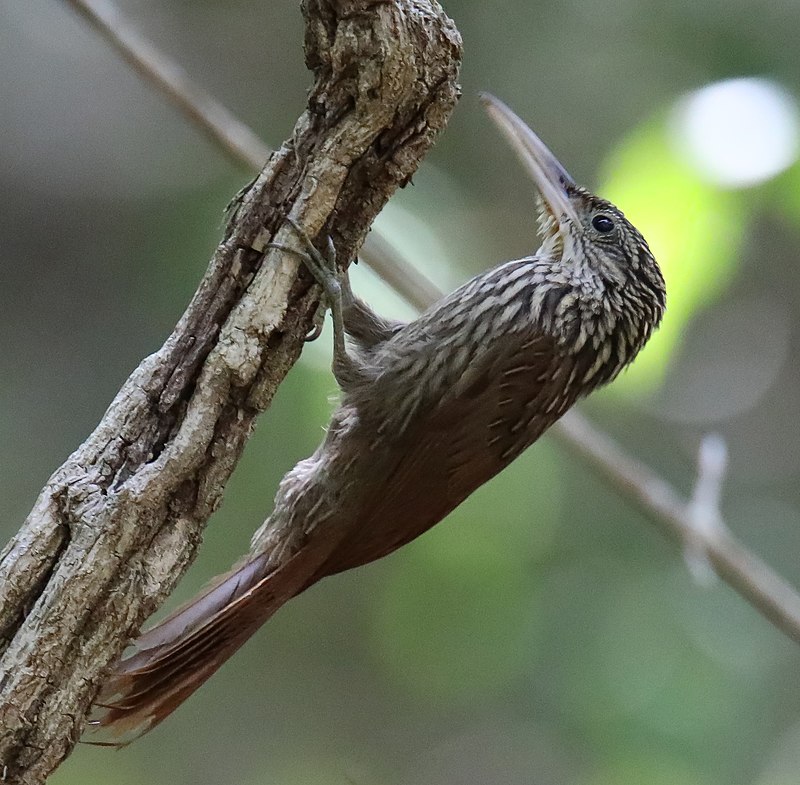
The ivory-billed woodcreeper is a noteworthy bird species found in tropical forests across Central America, including Belize, Costa Rica, El Salvador, Guatemala, Honduras, Mexico, and Nicaragua.
As a member of the Furnariidae family and the Dendrocolaptinae subfamily, this perching bird is characterized by its large size and commonality within its habitat.
Despite its unique features, there is limited information about the habits and behaviors of the ivory-billed woodcreeper.
These birds are predominantly found in dry and humid woodland areas, where they play a vital role in the forest’s ecosystem.
They are an essential component of the food chain and are preyed upon by larger birds of prey.
Overall, this bird species remains a mysterious but essential part of the Central American ecosystem.Scientific classification:
| Kingdom | Animalia |
| Phylum | Chordata |
| Class | Aves |
| Order | Passeriformes |
| Family | Furnariidae |
| Genus | Xiphorhynchus |
| Species | X. flavigaster |
33. White-Whiskered Puffbird
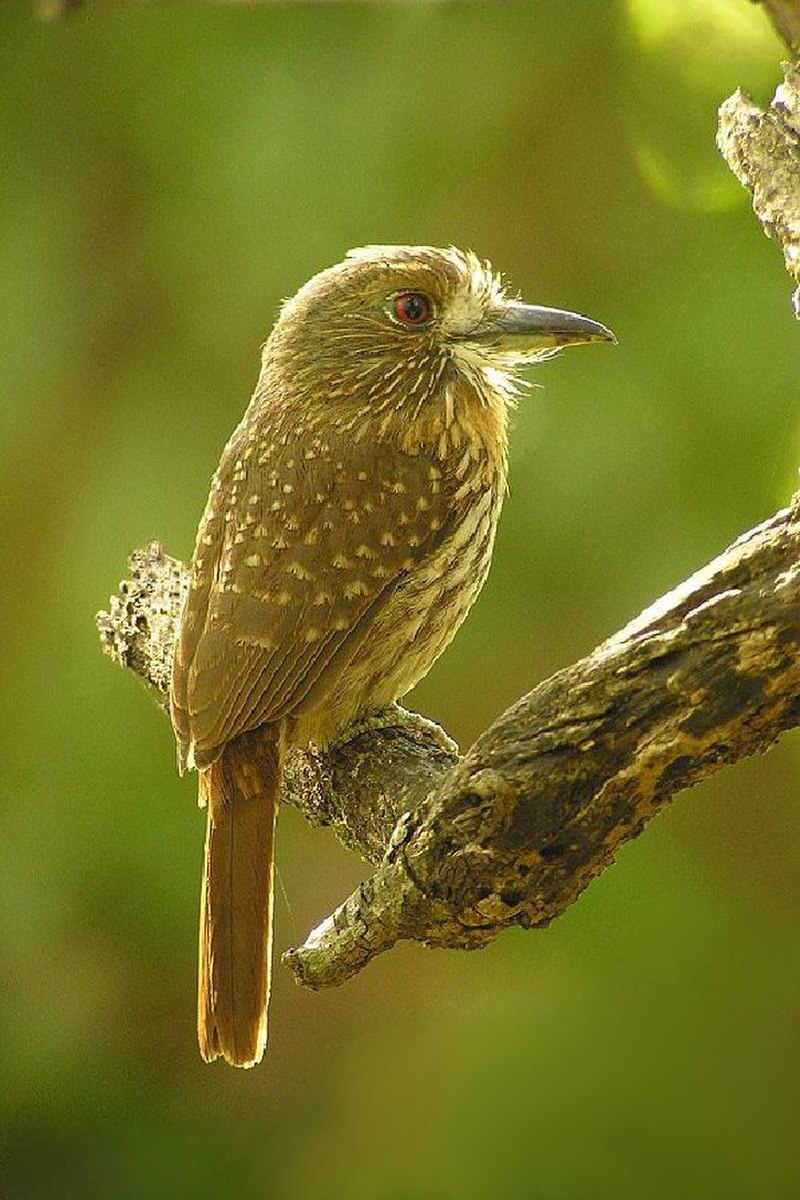
The white-whiskered puffbird, also known as the brown puffbird or white-whiskered soft-wing, is an adorable bird belonging to the puffbirds family.
This species is distributed from southeastern Mexico to Peru through Central America and Colombia, excluding El Salvador.
With four subspecies, the white-whiskered puffbird is characterized by its distinct white whiskers and soft wings.
As a near-passerine bird, it has a unique ability to perch and feed on snails and insects, making it an essential part of the ecosystem.
Although not threatened, its population remains stable, and it can be easily spotted in its natural habitat.
Overall, the white-whiskered puffbird is a beautiful bird with unique features that make it stand out in the wild.Scientific classification:
| Kingdom | Animalia |
| Phylum | Chordata |
| Class | Aves |
| Order | Piciformes |
| Family | Bucconidae |
| Genus | Malacoptila |
| Species | M. panamensis |
34. Grey-Headed Dove
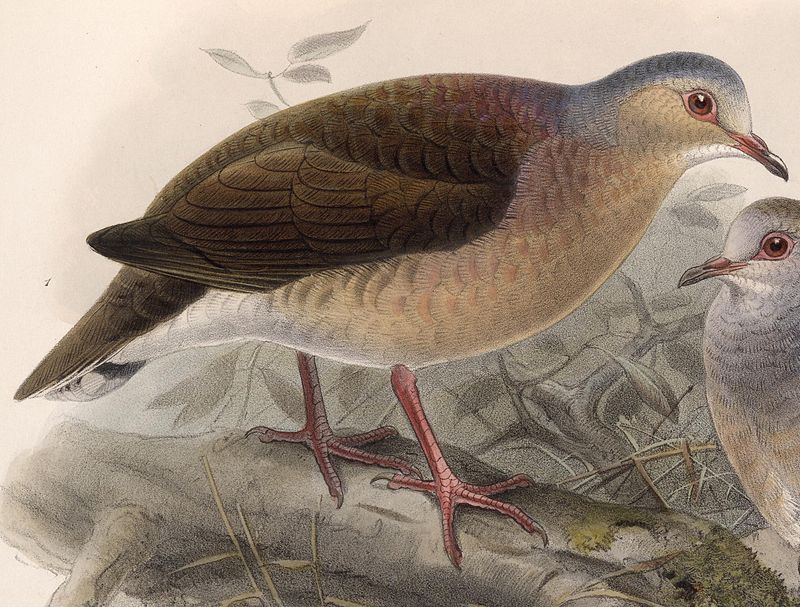
The Grey-headed dove, scientifically known as Leptotila plumbeiceps, is a bird found in several regions from Mexico through Colombia.
This large New World dove is often confused with similar species like the grey-fronted and pallid doves of South America, among others.
Previously, it was assumed that the Azuero dove of Central America, and the Grenada dove of Grenada were also part of the same species.
However, studies have since confirmed that they are distinct species. The Grey-headed dove has a distinct blue-grey head and neck, which contrast with its brownish body.
They are primarily found in forested areas, where they feed on seeds, fruit, and insects.
Despite being relatively common, there is little information about the Grey-headed dove’s population trends and conservation status at present.Scientific classification:
| Kingdom | Animalia |
| Phylum | Chordata |
| Class | Aves |
| Order | Columbiformes |
| Family | Columbidae |
| Genus | Leptotila |
| Species | L. plumbeiceps |
35. Grey-Crowned Yellowthroat
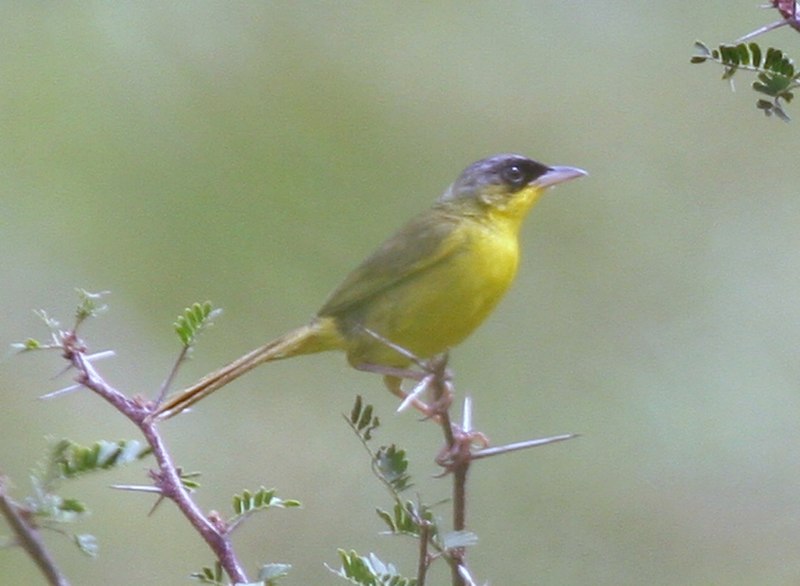
The Grey-crowned yellowthroat is a type of bird that belongs to the family of Parulidae. It can be found in various countries including Belize, Honduras, and the United States.
Its natural habitats include tropical moist shrubland and degraded forest areas. The bird has a grey head and a yellow throat. It is a small-sized bird and is mostly found in open areas.
Due to its habitat destruction, the species is now considered as threatened. To conserve their population, a number of conservation programs have been implemented.
Overall, the Grey-crowned yellowthroat is a beautiful bird that contributes to the biodiversity of the environment.Scientific classification:
| Kingdom | Animalia |
| Phylum | Chordata |
| Class | Aves |
| Order | Passeriformes |
| Family | Parulidae |
| Genus | Geothlypis |
| Species | G. poliocephala |
Also Featured In: Cozumel Birds You Didn’t Know,
36. Buff-Throated Saltator
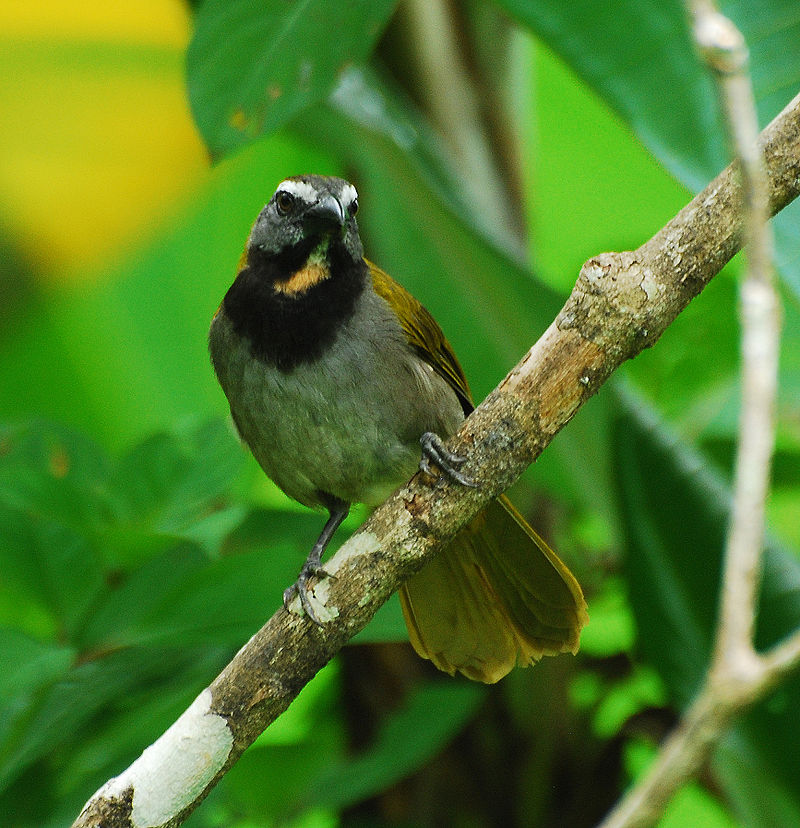
The buff-throated saltator is a type of bird that belongs to the tanager family. It can be found breeding in areas ranging from southeastern Mexico to Ecuador and northeastern Brazil.
This bird is known for being a seed-eater, and it typically weighs between 42 and 52 grams. With an average length of 20 cm, the buff-throated saltator is a relatively small bird. It has a slate-grey head that’s accentuated by a white supercilium and greenish crown.
The upperparts of the bird are olive green, while the underparts are a pale yellow color. This bird is known for its distinctive appearance and can be easily identified by its coloring and overall size.
While its habitat range is relatively narrow, it is still a common sight in many areas of South America.Scientific classification:
| Kingdom | Animalia |
| Phylum | Chordata |
| Class | Aves |
| Order | Passeriformes |
| Family | Thraupidae |
| Genus | Saltator |
| Species | S. maximus |